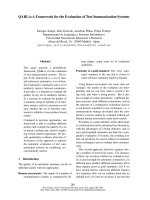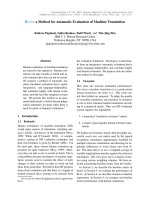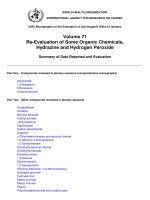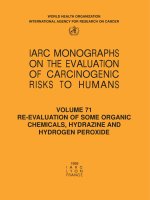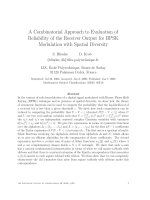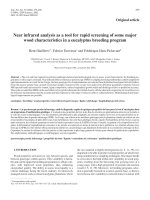A facile access and evaluation of some novel thiazole and 1,3,4-thiadiazole derivatives incorporating thiazole moiety as potent anticancer agents
Bạn đang xem bản rút gọn của tài liệu. Xem và tải ngay bản đầy đủ của tài liệu tại đây (1.31 MB, 8 trang )
Gomha et al. Chemistry Central Journal (2017) 11:105
DOI 10.1186/s13065-017-0335-8
RESEARCH ARTICLE
Open Access
A facile access and evaluation of some
novel thiazole and 1,3,4‑thiadiazole derivatives
incorporating thiazole moiety as potent
anticancer agents
Sobhi M. Gomha1* , Mohamad R. Abdelaziz2, Nabila A. Kheder1,3, Hassan M. Abdel‑aziz4, Seham Alterary5
and Yahia N. Mabkhot5*
Abstract
Background: Many heterocyclic compounds containing thiazole or 1,3,4-thiadiazole ring in their skeletons have
been reported to possess various pharmacological activities especially anticancer activities.
Results: 4-Methyl-2-phenylthiazole-5-carbohydrazide (2) was used as a synthon to prepare 2-(4-methyl-2-phe‑
nylthiazole-5-carbonyl)-N-phenylhydrazinecarbothioamide (3) and 2-(2-(4-methyl-2-phenylthiazole-5-carbonyl)
hydrazono)-N′-phenylpropane hydrazonoyl chlorides 5a–c. In addition, thioamide 3 was used as starting material for
preparation of a new series of thiadiazole derivatives via its reaction with hydrazonoyl chlorides 5a–c in dioxane using
triethylamines as catalyst. In addition, a series of thiazole derivatives was synthesized by reaction of thioamide 3 with
a number of α-halo compounds, namely, 3-chloropentane-2,4-dione (8) or 2-chloro-3-oxo-N-phenyl butanamide (10)
phenacyl bromide 12 ethyl chloroacetate (14) in EtOH in the presence of triethylamine. The structures assigned for all
the new products were elucidated based on both elemental analyses and spectral data and the mechanisms of their
formation was also discussed. Moreover, the new products was evaluated in vitro by MTT assays for their anticancer
activity against cell lines of Hepatocellular carcinoma cell line (HepG-2). The best result observed for compounds 7b
(IC50 = 1.61 ± 1.92 (μg/mL)) and 11 (IC50 = 1.98 ± 1.22 (μg/mL)). The structure–activity relationships have been sug‑
gested based on their anticancer results.
Conclusions: A novel series of new pharmacophores containing thiazole moiety have been synthesized using a
facile and convenient methods and evaluated as potent anticancer agents.
Keywords: Thiazoles, Thiadiazoles, Hydrazonoyl chlorides, Phenacyl bromide, Thioamide, Anticancer activity
Introduction
Identification of novel structure leads that may be of use
in designing new, potent, selective and less toxic anticancer agents remains a major challenge for medicinal chemistry researchers. Compounds containing thiazole core
have diverse biological activities as antihypertension,
*Correspondence: ;
1
Department of Chemistry, Faculty of Science, Cairo University,
Giza 12613, Egypt
5
Department of Chemistry, College of Science, King Saud University, P. O.
Box 2455, Riyadh 11451, Saudi Arabia
Full list of author information is available at the end of the article
antifungal, antimicrobial, anti-inflammatory, antioxidant, antitubercular [1–7], and anticancer [8–12]. Also,
thiazole ring present in many drugs such as Nizatidine,
Abafungin, and Amiphenazole (Fig. 1).
Many biological activities were reported for the compounds containing 1,3,4-thiadiazole ring such as antituberculosis, anti-inflammatory, antidepressant and
anxiolytic, antioxidant, anticonvulsants [13–17] and
anticancer activities [18–20]. In addition, many drugs
containing 1,3,4-thiadiazole ring are available in the market such as acetazolamide, methazolamide, and megazol
(Fig. 2).
© The Author(s) 2017. This article is distributed under the terms of the Creative Commons Attribution 4.0 International License
( which permits unrestricted use, distribution, and reproduction in any medium,
provided you give appropriate credit to the original author(s) and the source, provide a link to the Creative Commons license,
and indicate if changes were made. The Creative Commons Public Domain Dedication waiver ( />publicdomain/zero/1.0/) applies to the data made available in this article, unless otherwise stated.
Gomha et al. Chemistry Central Journal (2017) 11:105
Page 2 of 8
of 4-methyl-2-phenylthiazole-5-carbohydrazide (2) with
phenyl isothiocyanate in EtOH (Scheme 1).
The reaction of compound 2 with the appropriate hydrazonoyl chlorides 4a–c [32] in refluxing ethanol yielded the corresponding condensation product
5 (Scheme 2). The IR spectra of the latter products
revealed a carbonyl and two NH absorption bands (see
“Experimental” part). Their 1HNMR showed two D
2O
exchangeable signals of two NH protons in the regions
δ 10.03–10.06 and δ 10.57–10.59 ppm. Also, their mass
spectra confirmed the assigned structure 5 (Scheme 2).
Treatment of thioamide derivative 3 with the appropriate hydrazonoyl halides of type 5a–c in refluxing EtOH
In continuation of our studies dealing with the utility
of hydrazonoyl halides for synthesis of various bioactive
bridgehead nitrogen polyheterocycles [21–30], we wish
to report herein a new facile synthesis of new heterocycles containing thiazole and 1,3,4-thiadiazole or two thiazole rings in one molecular frame. We anticipated that
the synthesized compounds would have potent pharmacological activities.
Results and discussion
Chemistry
2-(4-Methyl-2-phenylthiazole-5-carbonyl)-N-phenylhydrazinecarbothioamide (3) [31] was prepared via reaction
Fig. 1 Some marketed drugs containing thiazole ring
Fig. 2 Examples of drugs containing a 1,3,4-thiadiazole ring
O
S
Ph
N
O
OEt
CH3
1
Scheme 1 Synthesis of thiazoles 2,3
NH2 NH2. H2 O
Ph
S
N
H
N
2
CH3
O
NH2
PhNCS / EtOH
S
Ph
N
NH
HN
S
CH3 HN Ph
3
Gomha et al. Chemistry Central Journal (2017) 11:105
Page 3 of 8
Scheme 2 Synthesis of thiadiazole derivatives 7a–c
containing TEA gave the corresponding thiadiazole
derivatives 7a–c (Scheme 2). Their structures were elucidated on the basis of their spectral data and elemental
analysis (see “Experimental”).
Next, refluxing of compound 3 with 3-chloropentane2,4-dione (8) or 2-chloro-3-oxo-N-phenyl butanamide (10)
in EtOH in the presence of triethylamine afforded the thiazole derivatives 9 and 11, respectively (Scheme 3).The structure of compounds 9 and 11 were elucidated based on their
elemental analysis and spectral data (see “Experimental”).
In a similar manner, thioamide 3 reacted with phenacyl
bromide 12 under the same experimental condition to afford
one isolable product 13 named as N′-(3,4-diphenylthiazol2(3H)-ylidene)-4-methyl-2-phenyl thiazole-5-carbohydrazide
(Scheme 3). The structure of thiazole 13 was established
based on its elemental analysis and spectral data (see
“Experimental”).
Finally, thioamide derivative 3 reacted with ethyl
chloroacetate (14) to afford thiazole 15 as showed in
Scheme 3. Its IR spectrum showed absorption bands at
v 3331 (NH), and 1726, 1648 (2C=O) cm−1. In addition,
its 1HNMR spectrum showed singlet signal at δ 4.23 ppm
due to the thiazolidinone (CH2) group.
(Cisplatin) in the same assay to compare the potency of
the synthesized compounds. The IC50 (the concentration
of test compounds required to kill 50% of cell population)
was determined (Table 1, Fig. 3).
The results of Table 1 revealed that the ascending order
of the cytotoxic activity of the newly synthesized compounds towards the human Hepatocellular carcinoma
cell line (HepG-2) were as follow: 5c < 13 < 5a < 5b < 9 <
7c < 15 < 7a < 11 < 7b (Fig. 4).
From the data of Table 1, we concluded the following
structure–activity relationships (SARs):
Anticancer activity
Experimental
The synthesized compounds were tested as anticancer agents against human Hepatocellular carcinoma
cell line (HepG-2) using colorimetric MTT assay. We
also included the well-known anticancer standard drug
•• The thiazole ring is essential for the activity.
•• Less number of thiazole ring as in compounds 5a–c
lead to drastic drop in activity.
•• 1,3,4-Thiadiazole ring is crucial for the cytotoxic
activity.
•• Presence of methyl group (electron donating group)
at position 4 of the phenyl ring in compound 7b
increase its activity more than compound 7a.
•• The presence of the N-phenylcarboxamide group
in compound 11 leads to increasing of its cytotoxic
activity.
Chemistry
General
Melting points were measured on an Electrothermal IA
9000 series digital melting point apparatus (Bibby Sci.
Gomha et al. Chemistry Central Journal (2017) 11:105
Page 4 of 8
COCH3
H
N
O
S
CH3
N
Ph
S
N
Cl
COCH3
N
Ph
8
S
Ph
S
Ph
N
H
N
S
N
CH3
11
N
Ph
CONHPh
CH3
EtOH / TEA
- HBr, -H2O
- HCl, -H2O
9
CONHPh
Cl
10
COCH3
EtOH / TEA
- HCl, -H2O
COPh
H S
N
N
H
CH3
N
H
H
N
O
12
EtOH / TEA
CH3
O
O
Br
COCH3
S
Ph
S
N
CH3
N
N
Ph
Ph
13
Ph
N 3
Cl
O
COOEt
14
EtOH / TEA
- HCl, -EtOH
S
Ph
N
H
N
S
N
CH3
N
Ph
O
15
Scheme 3 Synthesis of thiazole derivatives 9, 11, 13 and 15
Table 1 The in vitro inhibitory activity of the tested compounds against tumor cell lines expressed as IC50 values
(μg/mL) ± standard deviation from three replicates
Tested
compounds
IC50 (μg/mL)
Tested
compounds
IC50 (μg/mL)
Cisplatin
1.43 ± 2.03
7c
7.51 ± 0.64
5a
22.3 ± 2.41
9
17.4 ± 0.73
5b
20.3 ± 3.70
11
1.98 ± 1.22
5c
57.2 ± 7.12
13
35.1 ± 10.8
7a
2.14 ± 3.54
15
3.31 ± 2.65
7b
1.61 ± 1.92
Lim. Stone, Staffordshire, UK). IR spectra were measured on PyeUnicamSP 3300 and Shimadzu FTIR 8101 PC
infrared spectrophotometers (Shimadzu, Tokyo, Japan)
in potassium bromide discs. NMR spectra were measured on a Varian Mercury VX-300 NMR spectrometer
(Varian, Inc., Karlsruhe, Germany) operating at 300 MHz
(1HNMR) and run in deuterated dimethylsulfoxide
(DMSO-d6). Chemical shifts were related to that of the
solvent. Mass spectra were recorded on a Shimadzu
GCMS-QP1000 EX mass spectrometer (Tokyo, Japan)
at 70 eV. Elemental analyses were measured by using
a German made Elementarvario LIII CHNS analyzer.
2-(4-Methyl-2-phenylthiazole-5-carbonyl)-N-phenylhydrazinecarbothioamide (3) [31], and hydrazonoyl halides
4a–c [32] were prepared as reported in the respective
literature.
Synthetic procedures
Synthesis of hydrazonoyl chlorides 5a–c
A mixture of 4-methyl-2-phenylthiazole-5-carbohydrazide (2) (2.33 g, 10 mmol) and the appropriate hydrazonoyl chlorides 4a–c (10 mmol) in ethanol (30 mL) was
refluxed for 3–5 h (monitored through TLC).The resulting solid product was collected and recrystallized from
the proper solvent to give the corresponding products
5a–c.
2‑(2‑(4‑Methyl‑2‑phenylthiazole‑5‑carbonyl)hydrazono)‑
N′‑phenylpropane hydrazonoyl chloride (5a) Yellow
solid; yield (84%); m.p. 188–190 °C (EtOH); IR (KBr)
v 3440, 3316 (2NH), 3036, 2922 (CH), 1640 (C=O),
1599 (C=N) cm−1; 1H NMR (DMSO-d6) δ 2.36 (s, 3H,
CH3), 2.76 (s, 3H, CH3), 7.06–7.86 (m, 10H, ArH), 10.03
(s, br, 1H, D
2O-exchangeable NH), 10.57 (s, br, 1H,
D2O-exchangeable NH); MS m/z (%): 413 (M++2, 12),
411 (M+, 40), 375 (48), 202 (100), 174 (45), 71 (26). Anal.
Calcd for C20H18ClN5OS (411.91): C, 58.32; H, 4.40; N,
17.00. Found: C, 58.19; H, 4.37; N, 16.88%.
2‑(2‑(4‑Methyl‑2‑phenylthiazole‑5‑carbonyl)hydrazono)‑
N′‑(p‑tolyl)propane‑ hydrazonoylchloride (5b) Yellow
solid; yield (86%); m.p. 172–174 °C (EtOH); IR (KBr) v
3437, 3313 (2NH), 3041, 2917 (CH), 1679 (C=O), 1598
(C=N) cm−1; 1H NMR (DMSO-d6) δ 2.24 (s, 3H, CH3),
2.34 (s, 3H, CH3), 2.77 (s, 3H, CH3), 7.08–7.99 (m, 9H,
ArH), 10.06 (s, br, 1H, D2O-exchangeable NH), 10.59 (s,
br, 1H, D2O-exchangeable NH); MS m/z (%) 427 (M++2,
Gomha et al. Chemistry Central Journal (2017) 11:105
Page 5 of 8
60
IC50 values
50
40
30
20
10
0
Fig. 3 Comparison of the IC50 of the new synthesized compounds against Cisplatin
Ar =
Ph
S
N
CH3
O
CH3
H
Ar N
H3C
S
N
15
N
Ph
O
IC50 = 3.31 ± 2.65 µg/mL
HN N
Ar
N N
S
7a
H
Ar N
N
HN
Ar
S
N
11
IC50 = 2.14 ± 3.54 µg/mL
N
Ph
CONHPh
CH3
IC50 = 1.98 ± 1.22 µg/mL
H3C
HN N
Ar
N N
S
7b
N
HN
Ar
IC50 = 1.61 ± 1.92 µg/mL
Cisplatin
IC50 =1.43±2.03
Increasing order of cytotoxic activity
Fig. 4 The ascending order of the cytotoxic activity
10), 425 (M+, 33), 389 (26), 202 (81), 106 (100), 64 (66).
Anal. Calcd for C
21H20ClN5OS (425.93): C, 59.22; H, 4.73;
N, 16.44. Found: C, 59.18; H, 4.65; N, 16.37%.
N′‑(4‑Chlorophenyl)‑2‑(2‑(4‑methyl‑2‑phenylthiazole
‑5‑carbonyl)hydrazono) propane hydrazonoyl chloride
(5c) Yellow solid; yield (87%); m.p. 194–196 °C (DMF);
IR (KBr) v 3434, 3319 (2NH), 3044, 2926 (CH), 1682
(C=O), 1593 (C=N) cm−1; 1H NMR (DMSO-d6) δ 2.37
(s, 3H, C
H3), 2.77 (s, 3H, C
H3), 7.08–7.99 (m, 9H, Ar–H),
10.06 (s, br, 1H, D2O-exchangeable NH), 10.57 (s, br, 1H,
D2O-exchangeable NH); MS m/z (%) 446 (M+, 8), 283
(14), 202 (39), 104 (46), 80 (100), 64 (90). Anal. Calcd
for C20H17Cl2N5OS (446.35): C, 53.82; H, 3.84; N, 15.69.
Found: C, 53.75; H, 3.79; N, 15.58%.
Synthesis of 1,3,4‑thiadiazole derivatives 7a–c
A mixture of compound 3 (0.368 g, 1 mmol) and the
appropriate hydrazonoyl chlorides 5a–c (1 mmol) in
ethanol (20 mL) containing triethylamine (0.1 g, 1 mmol)
was refluxed for 6 h. The formed solid product was filtered, washed with methanol, dried and recrystallized
from the suitable solvents to give corresponding products 7a–c.
4‑Methyl‑N′‑(1‑(‑5‑(2‑(4‑methyl‑2‑phenylthiazole‑5‑
carbonyl)hydrazono)‑4‑phenyl‑4,5‑dihydro‑1,3,4‑thi‑
adiazol‑2‑yl)ethylidene)‑2‑phenylthiazole‑5‑
carbohydrazide(7a) Yellow solid; yield (74%); m.p.
162–164 °C (EtOH); IR (KBr) v 3421, 3307 (2NH),
3031, 2951 (CH), 1649 (C=O), 1596 (C=N) cm−1;
Gomha et al. Chemistry Central Journal (2017) 11:105
Page 6 of 8
1
H NMR (DMSO-d6) δ 2.34 (s, 3H, CH3), 2.66 (s, 3H,
CH3), 2.76(s, 3H, C
H3), 6.97-8.14 (m, 15H, ArH), 10.18
(s, br, 1H, D
2O-exchangeable NH), 11.17 (s, br, 1H,
D2O-exchangeable NH); MS m/z (%) 650 (M+, 34), 526
(30), 416 (60), 358 (28), 104 (55), 64 (100). Anal. Calcd for
C32H26N8O2S3 (650.80): C, 59.06; H, 4.03; N, 17.22. Found
C, 58.94; H, 4.01; N, 17.07%.
(NH), 3036, 2993 (CH), 1695, 1648 (2C=O), 1590 (C=N)
cm−1; 1H NMR(DMSO-d6) δ 2.32 (s, 3H, CH3),2.46 (s, 3H,
CH3), 2.77 (s, 3H, CH3), 6.91–7.86 (m, 10H, ArH), 10.61
(s, br, 1H, D
2O-exchangeable NH); MS m/z (%) 448 ( M+,
57), 246 (60), 176 (35), 104 (80), 77 (100). Anal.Calcd for
C23H20N4O2S2 (448.56): C, 61.59; H, 4.49; N, 12.49. Found
C, 61.48; H, 4.36; N, 12.37%.
4‑Methyl‑N′‑(1‑(5‑(2‑(4‑methyl‑2‑phenylthiazole‑5‑c
arbonyl)hydrazono)‑4‑(p‑tolyl)‑4,5‑dihydro‑1,3,4‑thi‑
adiazol‑2‑yl)ethylidene)‑2‑phenylthiazole‑5‑carbohy‑
drazide (7b) Yellow solid; yield (72%); m.p. 149–151 °C
(EtOH); IR (KBr) v 3422, 3328 (2NH), 3053, 2929 (CH),
1647 (C=O), 1597 (C=N) cm−1; 1H NMR (DMSOd6) δ 2.26 (s, 3H, CH3),2.35 (s, 3H, CH3), 2.65 (s, 3H,
CH3), 2.76(s, 3H, CH3), 6.91–8.03 (m, 14H, ArH), 10.18
(s, br, 1H, D
2O-exchangeable NH), 11.14 (s, br, 1H,
D2O-exchangeable NH); MS m/z (%) 664 (M+, 35), 553
(60), 334 (19), 202 (65), 104 (85), 64 (100). Anal. Calcd for
C33H28N8O2S3 (664.82): C, 59.62; H, 4.25; N, 16.85. Found
C, 59.47; H, 4.17; N, 16.79%.
4‑Methyl‑2‑(2‑(4‑methyl‑2‑phenylthiazole‑5‑carbonyl)
hydrazono)‑N‑3‑diphenyl‑2,3‑dihydrothiazole‑5‑carbox‑
amide (11) Yellow solid; yield (79%); m.p. 182–84 °C
(DMF); IR (KBr): v 3435, 3176 (2NH), 3030, 2928(CH),
1671, 1649 (2C=O), 1594 (C=N) cm−1; 1H NMR (DMSOd6) δ 2.36 (s, 3H, C
H3),2.76(s, 3H, C
H3), 6.97–7.73 (m,
15H, ArH), 10.46 (s, br, 1H, D
2O-exchangeable NH), 11.72
(s, br, 1H, D
2O-exchangeable NH); MS m/z (%) 525 ( M+,
7), 447 (16), 334 (100), 200 (59), 77 (89). Anal.Calcd for
C28H23N5O2S2 (525.64): C, 63.98; H, 4.41; N, 13.32. Found
C, 63.84; H, 4.30; N, 13.28%.
N′‑(3‑(4‑Chlorophenyl)‑5‑(1‑(2‑(4‑methyl‑2‑phenylt
hiazole‑5‑carbonyl)hydrazono)eth‑yl)‑1,3,4‑thiadia‑
zol‑2(3H)‑ylidene)‑4‑methyl‑2‑phenylthiazole‑5‑carbohy‑
drazide (7c) Yellow solid; yield (76%); m.p. 191–193 °C
(Dioxane); IR (KBr) v 3424, 3312 (2NH), 3047, 2932 (CH),
1649 (C=O), 1599 (C=N) cm−1; 1H NMR (DMSO-d6) δ
2.33 (s, 3H, CH3), 2.66 (s, 3H, CH3), 2.77(s, 3H, CH3), 6.90–
8.11 (m, 14H, ArH), 10.13 (s, br, 1H, D2O-exchangeable
NH), 11.19 (s, br, 1H, D2O-exchangeable NH); MS m/z
(%) 686 (M++2, 8), 684 (M+, 26), 513 (53), 368 (39), 257
(17), 104 (25), 64 (100). Anal.Calcd for C32H25ClN8O2S3
(685.24): C, 56.09; H, 3.68; N, 16.35. Found C, 56.02; H,
3.58; N, 16.22%.
General procedure for the synthesis of thiazole derivatives 9,
11, 13, and 15
A mixture of compound 3 (0.368 g, 1 mmol) and the
appropriate α-halo-compounds namely, 3-chloropentane-2,4-dione (8), 2-chloro-3-oxo-N-phenylbutanamide
(10), 2-bromo-1-phenyl ethanone (12) and ethyl 2-chloroacetate (14) (1 mmol for each) in ethanol (20 mL) containing triethylamine (0.1 g, 1 mmol) was refluxed for
4–6 h. (monitored by TLC The solid product was filtered,
washed with water, dried and recrystallized from the
proper solvent to give the corresponding thiazole derivatives 9, 11, 13, and 15, respectively.
N′‑(5‑Acetyl‑4‑methyl‑3‑phenylthiazol‑2(3H)‑ylidene)‑4
‑methyl‑2‑phenylthiazole‑5‑carbohydrazide (9) Yellow
solid; yield (78%); m.p. 155–157 °C (EtOH); IR (KBr) v 3432
N′‑(3,4‑Diphenylthiazol‑2(3H)‑ylidene)‑4‑methyl‑2‑ph
enylthiazole‑5‑carbohydrazide (13) Yellow solid; yield
(70%); m.p. 174–178 °C (EtOH); IR (KBr) v 3369 (NH),
3047, 2926(CH), 1648 (C=O), 1594 (C=N) cm−1; 1H
NMR (DMSO-d6) δ 2.75 (s, 3H, CH3), 7.03 (s, 1H, thiazole-H5), 7.35–8.02 (m, 15H, ArH), 10.73 (s, br, 1H,
D2O-exchangeable NH); MS m/z (%) 468
(M+, 25),
334 (100), 200 (40), 104 (69), 64(65). Anal.Calcd for
C26H20N4OS2 (468.59): C, 66.64; H, 4.30; N, 11.96. Found
C, 66.55; H, 4.21; N, 11.79%.
4‑Methyl‑N′‑(4‑oxo‑3‑phenylthiazolidin‑2‑ylidene)‑2‑p
henylthiazole‑5‑carbo‑ hydrazide (15) Yellowish-white
solid; yield (72%); m.p. 192–194 °C (Dioxane); IR (KBr)
v 3331(NH), 3036, 2926 (CH), 1726, 1648 (2C=O), 1596
(C=N) cm−1; 1H NMR (DMSO-d6) δ 2.65 (s, 3H, CH3),
4.23 (s, 2H, thiazolone-CH2), 7.40–7.88 (m, 10H, ArH),
10.82 (s, br, 1H, D2O-exchangeable NH); MS m/z (%) 408
(M+, 65), 334 (18), 202 (100), 104 (86), 64 (69). Anal.Calcd
for C20H16N4O2S2 (408.50): C, 58.80; H, 3.95; N, 13.72.
Found C, 58.68; H, 3.84; N, 13.64%.
Anticancer activity
The cytotoxic evaluation of the synthesized compounds
was carried out at the Regional Center for Mycology
and Biotechnology at Al-Azhar University, Cairo, Egypt
according to the reported method [33].
Conclusions
We successfully synthesized a series of novel heterocycles containing thiazole and 1,3,4-thiadiazole rings by a
facile and convenient method. The structure of the newly
Gomha et al. Chemistry Central Journal (2017) 11:105
prepared compounds was established based on both elemental analysis and spectroscopic data. The anticancer
activity of the synthesized compounds was measured and
showed promising activity.
Abbreviations
HepG2: human hepatocellular carcinoma; EtOH: ethanol; m.p.: melting point;
TEA: triethylamine; IR: infra-red; ATCC: American Type Culture Collection; TLC:
thin layer chromatography.
Authors’ contributions
SMG, NAK and YNM carried the literature study and designed synthetic
schemes, MRA and SA contributed in the synthesis and purification of the
compounds. All authors read and approved the final manuscript.
Author details
1
Department of Chemistry, Faculty of Science, Cairo University, Giza 12613,
Egypt. 2 Department of Pharmaceutical Chemistry, Faculty of Pharmacy, MIU
University, Cairo, Egypt. 3 Department of Pharmaceutical Chemistry, Faculty
of Pharmacy, King Khalid University, Abha 61441, Saudi Arabia. 4 Department
of Chemistry, Faculty of Science, University of Beni Suef, Beni Suef, Egypt.
5
Department of Chemistry, College of Science, King Saud University, P. O.
Box 2455, Riyadh 11451, Saudi Arabia.
Page 7 of 8
10.
11.
12.
13.
14.
15.
16.
Acknowledgements
The authors extend their sincere appreciation to the Deanship of Scientific
Research at the King Saud University for its funding this Prolific Research
group (PRG-1437-29).
17.
Competing interests
The authors declare that they have no competing interests.
19.
Publisher’s Note
18.
20.
Springer Nature remains neutral with regard to jurisdictional claims in pub‑
lished maps and institutional affiliations.
Received: 16 July 2017 Accepted: 10 October 2017
21.
22.
References
1. Karegoudar P, Karthikeyan MS, Prasad DJ, Mahalinga M, Holla BS, Kumari
NS (2008) Synthesis of some novel 2,4-disubstituted thiazoles as possible
antimicrobial agents. Eur J Med Chem 43:261–267
2. Gomha SM, Kheder NA, Abdelaziz MR, Mabkhot YN, Alhajoj AM (2017) A
facile synthesis and anticancer activity of some novel thiazoles carrying
1,3,4-thiadiazole moiety. Chem. Central J 11:25
3. Gomha SM, Abdel-Aziz HA (2012) Synthesis of new heterocycles derived
from 3-(3-methyl-1H-indol-2-yl)-3-oxopropanenitrile as potent antifungal
agents. Bull Kor Chem Soc 33:2985–2990
4. Kheder NA, Riyadh SM, Asiry AM (2013) Azoles and bis-Azoles: synthesis
and biological evaluation as antimicrobial and anti-cancer agents. Chem
Pharm Bull 61:504–510
5. Sharma PK, Sawhney SN, Gupta A, Singh GB, Bani S (1998) Synthesis and
antiinflammatory activity of some 3-(2-thiazolyl)-1,2-benzisothiazoles.
Indian J Chem 37B:376–381
6. Shih MH, Ying KF (2004) Syntheses and evaluation of antioxidant activity
of sydnonyl substituted thiazolidinone and thiazoline derivatives. Bioorg
Med Chem 12:4633–4643
7. Shiradkar M, Kumar GVS, Dasari V, Tatikonda S, Akula KC, Shah R (2007)
Clubbed triazoles: a novel approach to antitubercular drugs. Eur J Med
Chem 42:807–816
8. Gomha SM, Khalil KD (2012) A convenient ultrasound-promoted syn‑
thesis and cytotoxic activity of some new thiazole derivatives bearing a
coumarin nucleus. Molecules 17:9335–9347
9. Gomha SM, Salah TA, Abdelhamid AO (2015) Synthesis, characterization
and pharmacological evaluation of some novel thiadiazoles and thiazoles
23.
24.
25.
26.
27.
28.
29.
30.
incorporating pyrazole moiety as potent anticancer agents. Monatsh
Chem 146:149–158
Gomha SM, Riyadh SM, Abbas IM, Bauomi MA (2013) Synthetic utility of
ethylidenethiosemicarbazide: synthesis and anti-cancer activity of 1,3-thi‑
azines and thiazoles with imidazole moiety. Heterocycles 87:341–356
Gomha SM, Salah TA, Hassaneen HME, Abdel-aziz H, Khedr MA (2016)
Synthesis, characterization and molecular docking of novel bioactive
thiazolyl-thiazole derivatives as promising cytotoxic antitumor drug.
Molecules 21:1–17
Gomha SM, Abdelaziz MR, Abdel-aziz HM, Hassan SA (2017) Green syn‑
thesis and molecular docking of thiazolyl-thiazole derivatives as potential
cytotoxic agents. MiniRev Med Chem 17:805–815
Oruç EE, Rollas S, Kandemirli F, Shvets N, Dimoglo AS (2004) 1,3,4-thiadia‑
zole derivatives. Synthesis, structure elucidation, and structure-antituber‑
culosis activity relationship investigation. J Med Chem 47:6760–6767
Dawood KM, Abdel-Gawad H, Rageb EA, Ellithey M, Mohamed HA (2006)
Synthesis, anticonvulsant, and anti-inflammatory evaluation of some new
benzotriazole and benzofuran-based heterocycles. Bioorg Med Chem
14:3672–3680
Clerici F, Pocar D, Guido M, Loche A, Perlini V, Brufani M (2001) Synthesis
of 2-amino-5-sulfanyl-1,3,4-thiadiazole derivatives and evaluation of their
antidepressant and anxiolytic activity. J Med Chem 44:931–936
Foroumadi A, Kiani Z, Soltani F (2003) Antituberculosis agents VIII.
Synthesis and in vitro antimycobacterial activity of alkyl alpha-[5-(5-nitro2-thienyl)-1,3,4-thiadiazole-2-ylthio] acetates. Farmaco 58:1073–1076
Mullick P, Khan SA, Verma S, Alam O (2011) Thiadiazole derivatives as
potential anticonvulsant agents. Bull Kor Chem Soc 32:1011–1016
Gomha SM, Kheder NA, Abdelhamid AO, Mabkhot YN (2016) One pot
single step synthesis and biological evaluation of some novel bis(1,3,4thiadiazole) derivatives as potential cytotoxic agents. Molecules 21:1532
Gomha SM, Abdel-aziz HM, Khalil KD (2016) Synthesis and SAR study of
the novel thiadiazole-imidazole derivatives as new anti-cancer agents.
Chem Pharm Bull 64:1356–1363
Gomha SM, Badrey MG, Edrees MM (2016) Heterocyclization of a bis-thio‑
semicarbazone of 2,5-diacetyl-3,4-disubstituted-thieno[2,3-b]thiophene
bis-thiosemicarbazones leading to bis-thiazoles and bis-1,3,4-thiadiazoles
as anti-breast cancer agents. J Chem Res 40:120–125
Gomha SM (2009) A facile one-pot synthesis of 6,7,8,9-tetrahydrobenzo
[4,5]thieno [2,3-d]-1,2,4-triazolo[4,5-a]pyrimidin-5-ones. Monatsh Chem
140:213–220
Abdelhamid AO, Gomha SM, Abdelriheem NA (2017) Utility of 2-(5-met‑
hyl-1-phenyl-1H-pyrazol-4-yl)-2-oxo-N′-phenylaceto-hydrazonoyl bro‑
mide as precursor for synthesis of new functionalized heterocycles. Synth
Commun 47:999–1005
Abbas IM, Gomha SM, Elneairy MAA, Elaasser MM, Mabrouk BKA (2015)
Synthesis and characterization of some novel fused thiazolo[3,2-a]pyrimi‑
dinones and pyrimido[2,1-b][1,3]thiazinones. J Chem Res 39:719–723
Gomha SM, Riyadh SM (2009) Synthesis of triazolo[4,3-b][1,2,4,5]tetrazines
and triazolo[3,4-b][1,3,4]thiadiazines using chitosan as ecofriendly cata‑
lyst under microwave irradiation. Arkivoc 11:58–68
Abdallah MA, Riyadh SM, Abbas IM, Gomha SM (2005) Synthesis and
biological activities of 7-arylazo-7H-pyrazolo[5,1-c][1,2,4]triazolo-6(5H)ones and 7-arylhydrazono-7H-[1, 2, 4]triazolo[3,4-b][1,3,4]thiadiazines. J
Chin Chem Soc 52:987–994
Gomha SM, Badrey MG, Abdalla MM, Arafa RK (2014) Novel Anti-HIV-1
NNRTIs Based on a pyrazolo[4,3-d]isoxazole backbone scaffold: design,
synthesis and exploration of molecular basis of action. Med Chem Com‑
mun 5:1685–1692
Abbas IM, Riyadh SM, Abdallah MA, Gomha SM (2006) A novel route
to tetracyclic fused tetrazines and thiadiazines. J Heterocycl Chem
43:935–942
Dawood KM, Gomha SM (2015) Synthesis and anti-cancer activity of
1,3,4-thiadiazole and 1,3-thiazole derivatives having 1,3,4-oxadiazole
moiety. J Heterocycl Chem 52:1400–1405
Gomha SM, Riyadh SM (2014) Multicomponent synthesis of novel pentaheterocyclic ring systems incorporating benzopyranopyridines scaffold.
Synthesis 46:258–262
Gomha SM, Riyadh SM (2015) Cellulose sulfuric acid as an eco-friendly
catalyst for novel one-pot synthesis of pyrido[2,3-d][1,2,4]triazolo[4,3-a]
pyrimidin-5-ones. J Braz Chem Soc 26:916–923
Gomha et al. Chemistry Central Journal (2017) 11:105
31. Tiperciuc B, Zaharia V, Colosi I, Moldovan C, Crişan O, Pîrnau A, Vlase L,
Duma M, Oniga O (2012) Synthesis and evaluation of antimicrobial activ‑
ity of some new hetaryl-azoles derivatives obtained from 2-aryl-4-meth‑
ylthiazol-5-carbohydrazides and isonicotinic acid hydrazide. J Heterocycl
Chem 49:1407–1414
32. Shawali AS, Gomha SM (2000) A New entry for short and regioselective
synthesis of [1,2,4]triazolo[4,3-b][1,2,4]-triazin-7(1H)-one. Adv Synth Catal
342:599–604
Page 8 of 8
33. Gomha SM, Riyadh SM, Mahmmoud EA, Elasser MM (2015) Synthesis
and anticancer activities of thiazoles, 1,3-thiazines, and thiazolidine using
chitosan-grafted-poly(vinyl pyridine) as basic catalyst. Heterocycles
91:1227–1243
